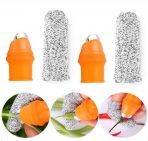by Stan Logan | Jul 14, 2020 | Garden tools, Irrigation
I think each of us battles with hoses and faucets that drip. When a faucet drips, it’s generally a leak that occurs at the base of the handle stem. You will probably notice that the handle is really easy to turn. What is supposed to seal the handle stem within the faucet is what is called a pressure washer. Over time these tend to shrink so that they no longer seal well against the stem. What you need to do is get an adjustable wrench and tighten the large nut at the base of the handle stem. This nut is probably “frozen” so you may have to use considerable force to tighten it. Hold the faucet firmly with your other hand to prevent damage elsewhere. Tighten the nut until the faucet handle is still easy to turn.
Many hose leaks occur where the hose attaches to the faucet. If you replace the rubber or plastic washer in the female fitting, your leak will generally be solved. Grab the old washer with pliers—a needle nose works best–and pull it out. Insert a new washer. If the hose end still leaks, try tightening it further. A channel lock wrench works well for this. If the leak continues, you may have to replace the female hose end. Washers and replacement hose ends are common in nurseries and hardware stores. Make sure though that you buy the proper size end replacement for your hose size—3/4”, 5/8”, or ½”. You may also choose to buy a new hose particularly if the old one is constantly kinking. Here I would advise you that you get what you pay for. Make sure that you are getting the right length to fit your needs—too much hose can be a pain also.
Now that I think of it, hose leaks frequently occur at the other end where you attach a sprayer of some kind. Here, again, the problem is generally the washer. If replacing the washer doesn’t help, check the end of the male hose fitting. If the surface that meets the washer is not smooth, you will need to flatten the end surface with a file. If the male hose end cannot be repaired, replace it noting the advice a gave you above. Of course, if the leak is within the sprayer attachment, it is time for it to go.
Stan, The Blog Man
P.S. LaVille, my editor, mentioned that the biggest problem with leaks is that your shoes get wet and can sometimes be ruined. So this is a very serious matter!

by Stan Logan | Jul 14, 2020 | Garden tools
I was out in the garden today doing maintenance. That’s my job. LaVille does the creating, and I try to do the maintaining. So I am deadheading—mainly Lantana—and it occurred to me that the job would be easier if I had a tool that would fit over my thumb and allow me to pinch off spent blooms. After lunch and the daily nap, I decided to see if there was actually such a tool, I googled “thumb garden pruner” and discovered that there were several models available. When I found they were available on Amazon, I went to the site and read over the comments on different brands. I chose a brand that offered a size option since my fingers definitely fit the large category—besides it was “Amazon’s Choice.” So my thumb knives will arrive in a couple days and I’ll give you a person evaluation.

Thumb Knives
I would give this device 4 out of 5 stars. My first problem was that I had trouble inserting my thumb. Although I ordered the “large” version, it was too snug. Perhaps it is designed for a woman’s large thumb—and indeed it fits LaVille’s thumb just fine. I measured the circumference of my thumb and it was 3 1/8 inches. Now before you call Guinness World Records, let you remind you that this is circumference. Remember how you get diameter out of circumference? Dividing 3 1/8 by 3.14, you get 1 inch. See—no freak here. So maybe that gives you some idea of the size you need. Anyway, as I tried to pull the device on, it separated. Re-attaching the two parts was a challenge, but I succeeded. The first plant I attacked was a gazania that had gone crazy with blooms. For a long time I attempted to severe the flower stalks by pinching between the thumb blade and my sleeve protected forefinger. It didn’t take too long for my forefinger to get sore. I thought that the thumb knife would be used in the same manner that I had used to deadhead by pinching my thumbnail against my forefinger. I discovered that no pinching is needed. You simply twist your wrist downward so that the knife edge presses against the stalk. So why is this device better than what you have been doing forever? First, you can cut the stalk deep in the plant by sliding your hand down the stalk. Then, since the cut stalk in already in your hand, you can simply move to another stalk without using your other hand. Also, since you are using only one hand, you don’t have to bend over as far to get both hands involved. Now I have to tell you that LaVille loves this tool. She was even using it without the forefinger sleeve. She said that in some instances she used the cutting edge to slice through a bunch of stalks she had gathered in her other hand. So she would rate the thumb knife 5 stars. If you choose to use the thumb knife, eventually it will lose its razor sharp edge. I can sharpen it for you if that ever happens. I guess I’ll have to say it’s “thumbs up” for the thumb knife.
Happy deadheading, Stan The Tool Man

